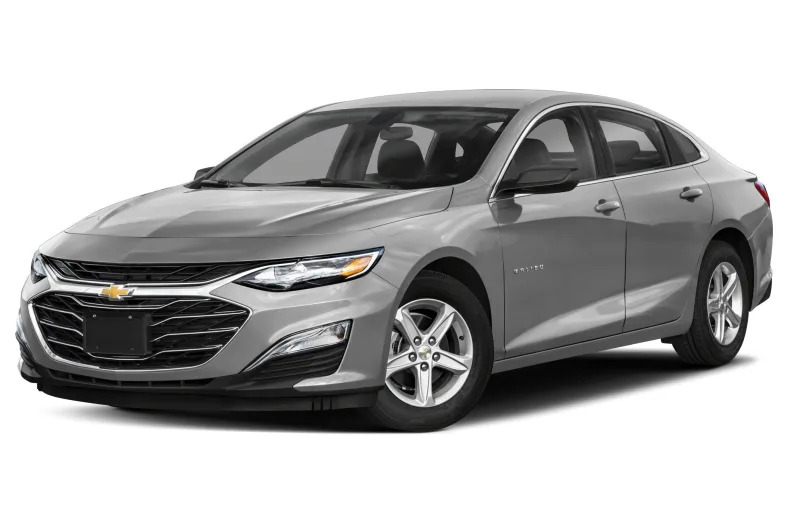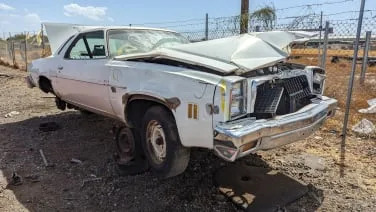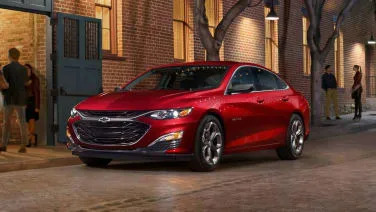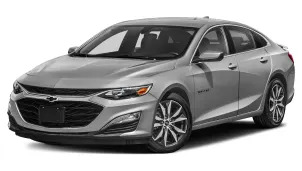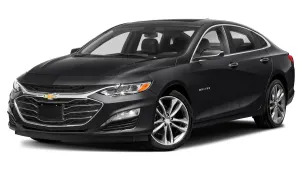2020 Chevrolet Malibu
Largely overlooked and dwarfed by the barrage of crossovers and SUVs, the 2020 Chevrolet Malibu ranks around the middle of the shrinking midsize sedan segment. The Malibu, one of Chevy's oldest nameplates, is stylish and comfortable, but lacks modern active safety features. Changes are minimal for the 2020 model year following last year's mid-cycle refresh. Two new exterior colors are available, while a new grille and restyled wheels have been installed on the RS trim. Following slow sales, the thrifty Malibu Hybrid has been dropped from the lineup.
Chevrolet offers two turbocharged engines for the Malibu. Most models get a 1.5-liter turbo 4-cylinder that makes 160 horsepower and 184 pound-feet of torque, mated with a continuously variable automatic transmission (CVT). Chevy's version features simulated 'gears'? that minimize the rubber-band sensation and droning that still affect many CVTs. Not only does the Malibu's CVT feel more natural, its engine doesn't have to rev high to deliver more power.
The range-topping Premier model gets a 2.0-liter turbo-4 that delivers 250 horsepower and 260 pound-feet of torque. Instead of a CVT, the Premier uses a smooth 9-speed automatic transmission. All Malibus have front-wheel drive.
Frugal with the 1.5-liter engine, in particular, the Malibu's fuel-efficiency also benefits from “intelligent” transmissions. With the smaller turbo-4 and CVT, the Malibu is EPA-rated at 29 mpg city, 36 highway, 32 combined.
Estimates drop substantially with the more powerful 2.0-liter turbo-4 and conventional transmission to 22/32/26 mpg. Drivers who often hit the highway might consider the additional power worth the higher fuel cost, but it demands more stops at the gas station. The larger engine also requires premium-grade gasoline.
Chevrolet doesn't make it easy to obtain a Malibu with active safety technology, none of which comes standard. Worse yet, none of these features become available until the second-from-the-top LT trim.
At this level, the Driver Confidence Package adds automatic emergency braking, forward-collision warnings, active lane control, lane-departure warnings, rear parking sensors, lane change alert, blind-spot monitors, rear cross-traffic alert, and automatic high-beam headlights. On the Premier trim, this bundle is more expensive because it also includes adaptive cruise control, an automated parking system, and a more advanced automatic emergency braking system.
At least crash test scores are decent. The Malibu carries a four-star overall safety rating from the NHTSA, and received the top score of 'Good'? on all of the IIHS' tests besides the passenger-side small overlap front, where it earned a 'Marginal'? grade.
Full Review
Full Review
Changes are minimal for the 2020 model year following last year's mid-cycle refresh. Two new exterior colors are available, while a new grille and restyled wheels have been installed on the RS trim. Following slow sales, the thrifty Malibu Hybrid has been dropped from the lineup.
Chevrolet offers two turbocharged engines for the Malibu. Most models get a 1.5-liter turbo 4-cylinder that makes 160 horsepower and 184 pound-feet of torque, mated with a continuously variable automatic transmission (CVT). Chevy's version features simulated 'gears'? that minimize the rubber-band sensation and droning that still affect many CVTs. Not only does the Malibu's CVT feel more natural, its engine doesn't have to rev high to deliver more power.
The range-topping Premier model gets a 2.0-liter turbo-4 that delivers 250 horsepower and 260 pound-feet of torque. Instead of a CVT, the Premier uses a smooth 9-speed automatic transmission. All Malibus have front-wheel drive.
Frugal with the 1.5-liter engine, in particular, the Malibu's fuel-efficiency also benefits from “intelligent” transmissions. With the smaller turbo-4 and CVT, the Malibu is EPA-rated at 29 mpg city, 36 highway, 32 combined.
Estimates drop substantially with the more powerful 2.0-liter turbo-4 and conventional transmission to 22/32/26 mpg. Drivers who often hit the highway might consider the additional power worth the higher fuel cost, but it demands more stops at the gas station. The larger engine also requires premium-grade gasoline.
Chevrolet doesn't make it easy to obtain a Malibu with active safety technology, none of which comes standard. Worse yet, none of these features become available until the second-from-the-top LT trim.
At this level, the Driver Confidence Package adds automatic emergency braking, forward-collision warnings, active lane control, lane-departure warnings, rear parking sensors, lane change alert, blind-spot monitors, rear cross-traffic alert, and automatic high-beam headlights. On the Premier trim, this bundle is more expensive because it also includes adaptive cruise control, an automated parking system, and a more advanced automatic emergency braking system.
At least crash test scores are decent. The Malibu carries a four-star overall safety rating from the NHTSA, and received the top score of 'Good'? on all of the IIHS' tests besides the passenger-side small overlap front, where it earned a 'Marginal'? grade.
Hide Full Review
Retail Price
| Engine | 1.5L I-4, 2.0L I-4 |
| MPG | Up to 29 city / 36 highway |
| Seating | 5 Passengers |
| Transmission | 2-spd CVT w/OD, 9-spd auto w/OD |
| Power | 160 - 250 hp |
| Drivetrain | front-wheel |
| Curb Weight | 3,126 - 3,223 lbs |

